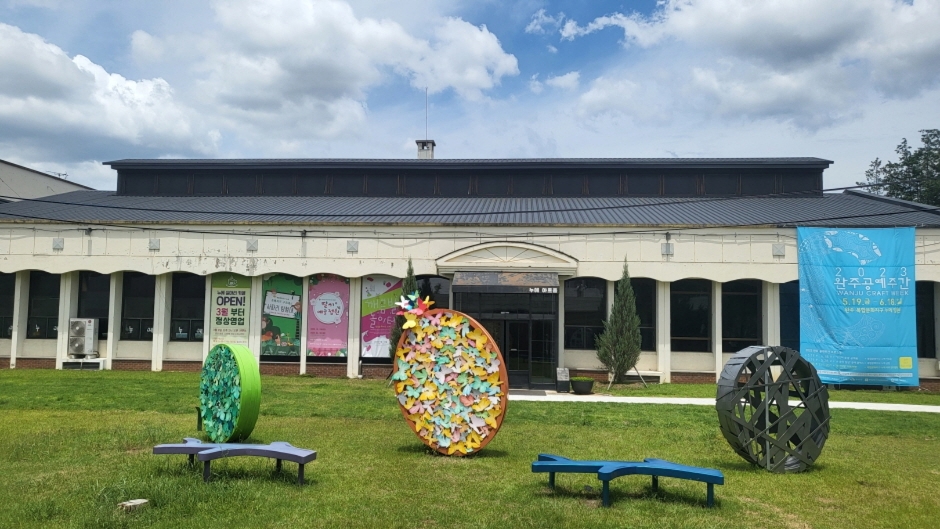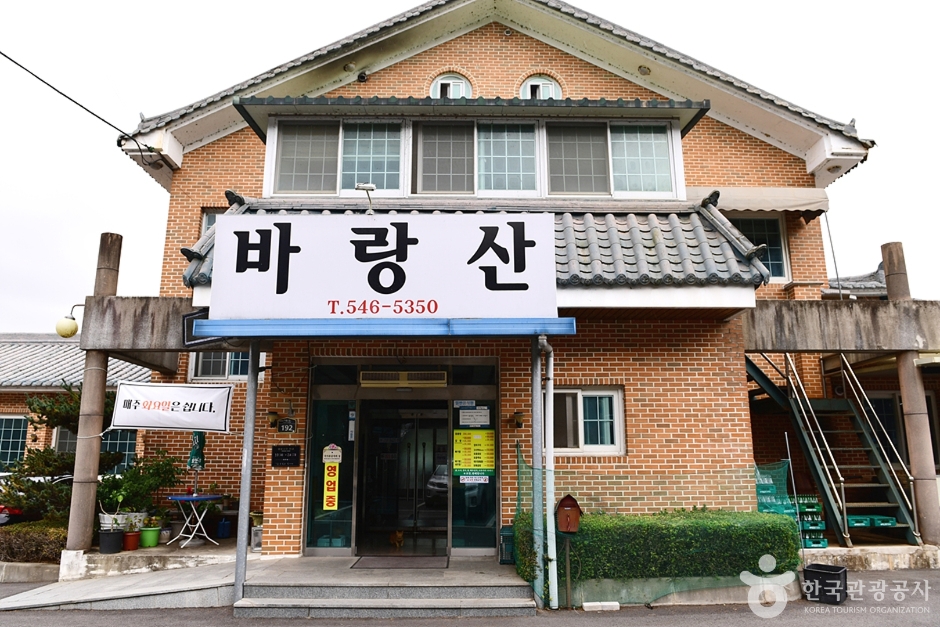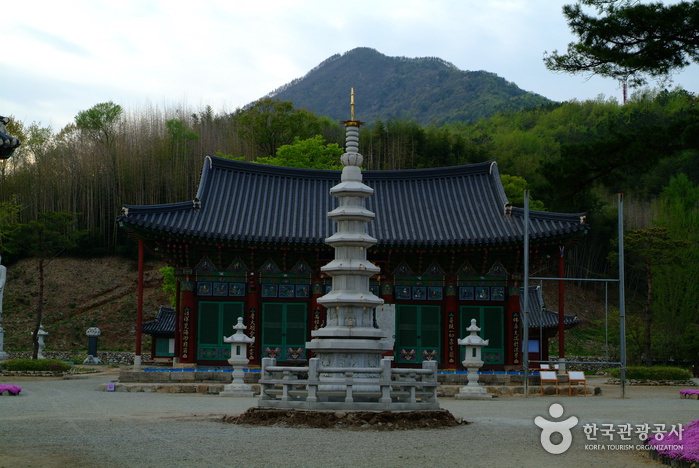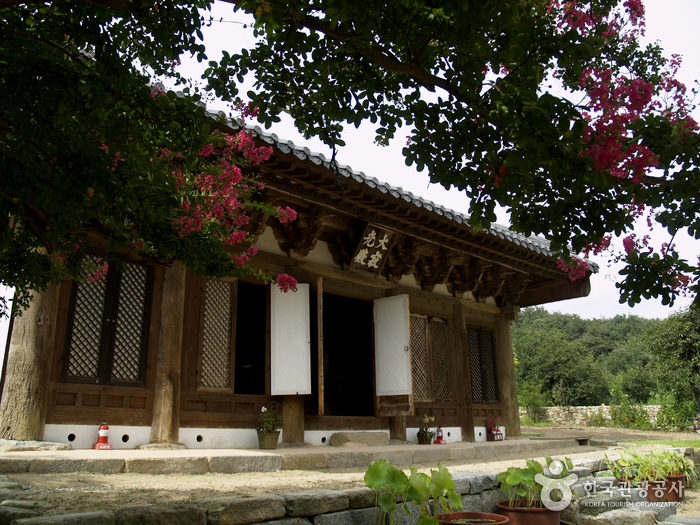Yeolimjae Pension[Korea Quality] / 여림재펜션[한국관광 품질인증]
9.7 Km 0 2024-04-07
96 , Jungnimpyeonbaek-gil, Wanju-gun, Jeonbuk-do
+82-10-8375-0258
Yeolimjae Pension is a newly built modern three-story pension located in Wanju, Jeollabuk-do. The pension has five guest rooms, ranging from couple rooms for two people to family rooms. Each room comes with a bathroom, a kitchen, and a private terrace. From the terrace, you can enjoy a cup of tea while taking in the mountain scenery. The garden includes an outdoor swimming pool and a picnic table adjacent to it. Be sure to check the availability of the barbecue area in advance since it differs from room to room. Nearby tourist attractions include Sanggwan Cypress Forest, Jeonju Hanok Village, and Ongnyeobong Peak Valley.
Open Space Nu-e (복합문화지구 누에)
10.1 Km 0 2024-04-06
462-9 , Wanju-ro, Wanju-gun, Jeonbuk-do
Nu-e, a complex cultural district located in Wanju-gun, Jeollabuk-do, opened with the goal of "a living space where everyone communicates through art." As part of the cultural regeneration project, it was built in the Jeollabuk-do Jameop (silkworm business) testing center complex and is carrying out projects such as cultural and artistic education, exhibition planning, and the creation of creative spaces. Facilities include Nu-e Art Hall, where various art exhibitions and performances are held, guesthouse 'Sum' for local residents, a camping ground and lounge, a pottery room, a kiln room, etc. There is a children's space called "Dreaming Nu-e Playground" where adults are not permitted, making it a good place for family trips. It is also recommended to visit the Jeonbuk Provincial Museum of Art and Samnye Culture and Art Village, representative tourist facilities in Wanju-gun.
MOAKSAN MOTEL [Korea Quality] / 모악산 모텔 [한국관광 품질인증]
10.2 Km 25438 2020-09-10
104-10, Moaksan-gil, Gui-myeon, Wanju_Gun, Jeonbuk-do, Korea
+82-10-5333-3022
The Moaksan Motel is located in the tourism complex at Moaksan Mountain. Newly refurbished and re-opened, it is known as a clean, cozy hotel offering a high standard of customer satisfaction. The tourism complex comprises a large public parking lot, local food restaurants, and a football pitch among other facilities. Moaksan Mountain is a popular hiking destination among hikers and the people of Jeonju. In addition, the hotel is just three minutes’ walk from the Jeonbuk Province Art Museum, while Gui Reservoir, where the National Canoe Championships is held by the Korea Canoe Federation, is situated in front of the hotel. The hotel also offers easy access to public transportation as the bus stop (Bus No. 970) is situated in the tourism complex, allowing guests to travel directly to Jeonju Bus Terminal.
Moaksan Mountain (모악산)
10.2 Km 60020 2024-04-07
Gui-myeon, Wanju-gun, Jeonbuk-do
Moaksan Mountain is a mountain with an elevation of 793 meters, spanning across Gui-myeon in Wanju-gun, and Geumsan-myeon in Gimje-si, Jeollabuk-do. It overlooks the Honam Plain, a major agricultural region in Korea, and houses the precious Buddhist cultural heritage site, Geumsansa Temple, along with its subsidiary hermitages. To the north of the mountain lies the beautiful Gui Reservoir, and there are walking paths around the reservoir, providing a pleasant walking experience.
Korea Expressway Corporation Arboretum (한국도로공사수목원)
10.5 Km 43231 2024-05-28
462-45 Beonyeong-ro, Deokjin-gu, Jeonju-si, Jeonbuk-do
+82-63-212-0652
The Korea Expressway Corporation Arboretum is located in Jeonju and operated by Korea Expressway Corporation. The arboretum was opened to counterbalance the environmental damage caused by the construction of expressways. As such, the arboretum maintains and promotes the conservation of many beautiful flora from across the country.
Barangsan Garden (바랑산가든)
11.1 Km 20288 2024-04-07
192 Daeyul 2-gil, Geumgu-myeon, Gimje-si, Jeonbuk-do
Barangsan Garden is a maeuntang (spicy fish stew) restaurant where visitors can enjoy their meal while admiring the scenery of Daeyul Reservoir. Their flagship dish is the megi tang (spicy catfish stew) made by boiling wild catfish and dried radish in a perilla seeds broth with seasoning. Other popular menu items include jap tang (assorted spicy seafood stew) made with freshwater fish and minmul jangeo gui (grilled freshwater eel).
Wanju Songgwangsa Temple (송광사(완주))
11.2 Km 20795 2024-04-07
255-16, Songgwangsuman-ro, Wanju-gun, Jeonbuk-do
+82-63-243-8091
Songgwangsa Temple in Wanju-gun, Jeollabuk-do has a unique history that spans a period of over a thousand years. For many years the temple lay incomplete until Monk Bojo Chejing began reconstruction in the 7th year of King Gyeongmun of Silla (AD 867). The temple was destroyed at one point in time, but Master Monk Jinul prayed that it be rebuilt. In accordance with his fervent hopes, in the 1600s the monk’s followers rebuilt a number of the temple’s halls and buildings, many of which can still be seen today. The temple is also remembered as the temple that King Injo helped rebuild with the hope that his two sons, who had been taken hostage by the Qing dynasty during the Byeongjahoran War (Chinese invasion of Korea in 1636), would be returned safely and that Buddha would heal the nation.
One of the Korea’s four major temples, Songgwangsa is home to Jijangbosal and Siwangsang statues (found in Jijangjeon Hall), a Seokgayeorae statue, and 500 Nahansang statues (found in Nahanjeon Hall). The temple is also home to eight Tangible Cultural Assets and four Treasured Cultural Assets: Daeungjeon Hall, the Samsebulsang statues, the bell-tower, and the Sacheonwangsang statue.
Beloved for its historical significance as well as its beauty, the temple draws throngs of worshipers throughout the year. In spring, many tourists flock to the area to explore the temple and walk through the nearby cherry blossom tunnels. A worthwhile attraction for visitors of all ages, the temple is particularly well-suited for those with mobility problems since it is located on ground level.
Happydream [Korea Quality] / 행복드림한옥 [한국관광 품질인증]
11.3 Km 9897 2024-04-07
181-21 , Bongseoan-gil, Wanju-gun, Jeonbuk-do
+82-63-247-0050, +82-10-3677-5339
Dueok Happydream Village is located in Bongseo-gol, Wanju-gun, Jeollabuk-do - a location said to be one of the most propitious in Korea, owing to the surrounding mountains’ resemblance to the Bonghwang mythical bird. The guesthouse’s tile-roofed buildings are set in a wide grassy yard against a background of green mountains. As well as accomodation the village operates various nature and traditional culture experience programs, some of which take place at the guesthouse. The rooms are small but clean and comfy, and with the doors open offer scenic views.
Gwisinsa Temple - Gimje (귀신사 - 김제)
12.0 Km 9495 2024-04-07
40, Cheongdo 6-gil, Gimje-si, Jeonbuk-do
+82-63-548-0917
Gwisinsa, located in Cheongdo Village, Geumsan-myeon, Gimje-si, is now a temple of the Jogye Order, but once belonged to the Haweom Order. The temple is widely believed to have been established by the great monk Uisang Daesa during the 16th year of King Munmu (676). However, some experts site the existence of the Namgeunseok stone animal sculpture as proof that the temple was originally the private temple of King Beop of the Baekje Kingdom.
Throughout history, the temple has had many names—Guksinsa, Gwisinsa, Gusunsa, and Gwisinsa (same English spelling, different meaning)—but not much is known about when the temple was called by which name. On the temple grounds are a 3-story stone pagoda and some stone sculptures including seoksu (animal statues) and budo (a stupa in honor of a great master). Inside the temple are Daejeokgwangjeon Hall (Treasure No.826), Myeongbujeon Hall, and Gongyangjib Chamber (a chamber for Buddhist offerings).
Wanju Samrye Culture & Arts Village (완주 삼례문화예술촌)
12.4 Km 3319 2024-04-07
81-13, Samnyeyeok-ro, Wanju-gun, Jeonbuk-do
+82-63-290-3862
Samrye Culture & Arts Village is an art village also referred to as "Samsamyeyemimi." Once used as a granary and an official residence during the Japanese administration, it has now become a village of art. The village consists of Design Museum, Visual Media Art Gallery, Kim Sang-rym Carpentry Shop (Wood Works), and Book Museum and offers a variety of programs during exhibition events and art festivals.
![Yeolimjae Pension[Korea Quality] / 여림재펜션[한국관광 품질인증]](http://tong.visitkorea.or.kr/cms/resource/66/2814866_image2_1.jpg)




![Happydream [Korea Quality] / 행복드림한옥 [한국관광 품질인증]](http://tong.visitkorea.or.kr/cms/resource/48/3008848_image2_1.jpg)

 English
English
 한국어
한국어 日本語
日本語 中文(简体)
中文(简体) Deutsch
Deutsch Français
Français Español
Español Русский
Русский